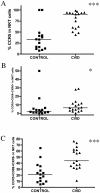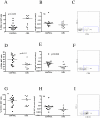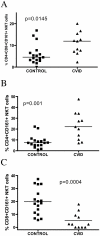Skewed distribution of circulating activated natural killer T (NKT) cells in patients with common variable immunodeficiency disorders (CVID)
- PMID: 20844745
- PMCID: PMC2936579
- DOI: 10.1371/journal.pone.0012652
Skewed distribution of circulating activated natural killer T (NKT) cells in patients with common variable immunodeficiency disorders (CVID)
Abstract
Common variable immunodeficiency disorder (CVID) is the commonest cause of primary antibody failure in adults and children, and characterized clinically by recurrent bacterial infections and autoimmune manifestations. Several innate immune defects have been described in CVID, but no study has yet investigated the frequency, phenotype or function of the key regulatory cell population, natural killer T (NKT) cells. We measured the frequencies and subsets of NKT cells in patients with CVID and compared these to healthy controls. Our results show a skewing of NKT cell subsets, with CD4+ NKT cells at higher frequencies, and CD8+ NKT cells at lower frequencies. However, these cells were highly activated and expression CD161. The NKT cells had a higher expression of CCR5 and concomitantly expression of CCR5+CD69+CXCR6 suggesting a compensation of the remaining population of NKT cells for rapid effector action.
Conflict of interest statement
Figures




Similar articles
-
Human natural killer T cells are heterogeneous in their capacity to reprogram their effector functions.PLoS One. 2006 Dec 20;1(1):e50. doi: 10.1371/journal.pone.0000050. PLoS One. 2006. PMID: 17183680 Free PMC article.
-
CD4+CD25+Foxp3+ T regulatory cells, Th1 (CCR5, IL-2, IFN-γ) and Th2 (CCR4, IL-4, Il-13) type chemokine receptors and intracellular cytokines in children with common variable immunodeficiency.Int J Immunopathol Pharmacol. 2016 Jun;29(2):241-51. doi: 10.1177/0394632015617064. Epub 2015 Dec 18. Int J Immunopathol Pharmacol. 2016. PMID: 26684629 Free PMC article.
-
Skewed Invariant Natural Killer T (iNKT) Cells, Impaired iNKT:B Cell Help and Decreased SAP Expression in Blood Lymphocytes from Patients with Common Variable Immunodeficiency.Scand J Immunol. 2017 Sep;86(3):171-178. doi: 10.1111/sji.12576. Scand J Immunol. 2017. PMID: 29083052
-
Abnormality of regulatory T cells in common variable immunodeficiency.Cell Immunol. 2017 May;315:11-17. doi: 10.1016/j.cellimm.2016.12.007. Epub 2016 Dec 29. Cell Immunol. 2017. PMID: 28284485 Review.
-
The Role of Natural Killer T Cells in Cancer-A Phenotypical and Functional Approach.Front Immunol. 2018 Feb 27;9:367. doi: 10.3389/fimmu.2018.00367. eCollection 2018. Front Immunol. 2018. PMID: 29535734 Free PMC article. Review.
Cited by
-
A Clinical and Laboratory Approach to the Evaluation of Innate Immunity in Pediatric CVID Patients.Front Immunol. 2015 Apr 27;6:145. doi: 10.3389/fimmu.2015.00145. eCollection 2015. Front Immunol. 2015. PMID: 25964782 Free PMC article.
-
Opinion Article: NK Cells in Cutaneous Leishmaniasis: Protection or Damage?Front Immunol. 2022 Jul 1;13:933490. doi: 10.3389/fimmu.2022.933490. eCollection 2022. Front Immunol. 2022. PMID: 35844579 Free PMC article. No abstract available.
-
IVIg immune reconstitution treatment alleviates the state of persistent immune activation and suppressed CD4 T cell counts in CVID.PLoS One. 2013 Oct 9;8(10):e75199. doi: 10.1371/journal.pone.0075199. eCollection 2013. PLoS One. 2013. PMID: 24130688 Free PMC article. Clinical Trial.
-
Application of user-guided automated cytometric data analysis to large-scale immunoprofiling of invariant natural killer T cells.Proc Natl Acad Sci U S A. 2013 Nov 19;110(47):19030-5. doi: 10.1073/pnas.1318322110. Epub 2013 Nov 4. Proc Natl Acad Sci U S A. 2013. PMID: 24191009 Free PMC article.
-
Defective functions of polymorphonuclear neutrophils in patients with common variable immunodeficiency.Immunol Res. 2014 Oct;60(1):69-76. doi: 10.1007/s12026-014-8555-7. Immunol Res. 2014. PMID: 24981124
References
-
- Agematsu K, Futatani T, Hokibara S, Kobayashi N, Takamoto M, et al. Absence of memory B cells in patients with common variable immunodeficiency. Clin Immunol. 2002;103:34–42. - PubMed
-
- Haymore BR, Mikita CP, Tsokos GC. Common variable immune deficiency (CVID) presenting as an autoimmune disease: role of memory B cells. Autoimmun Rev. 2008;7:309–312. - PubMed
-
- Livaditi O, Giamarellos-Bourboulis EJ, Kakkas I, Kapsimali V, Lymberi P, et al. Grouping of patients with common variable immunodeficiency based on immunoglobulin biosynthesis: comparison with a classification system on CD4-naive cells. Immunol Lett. 2007;114:103–109. - PubMed
-
- Viallard JF, Blanco P, Andre M, Etienne G, Liferman F, et al. CD8+HLA-DR+ T lymphocytes are increased in common variable immunodeficiency patients with impaired memory B-cell differentiation. Clin Immunol. 2006;119:51–58. - PubMed
-
- Vodjgani M, Aghamohammadi A, Samadi M, Moin M, Hadjati J, et al. Analysis of class-switched memory B cells in patients with common variable immunodeficiency and its clinical implications. J Investig Allergol Clin Immunol. 2007;17:321–328. - PubMed
Publication types
MeSH terms
Substances
Grants and funding
LinkOut - more resources
Full Text Sources
Other Literature Sources
Research Materials

